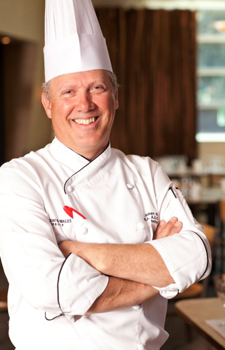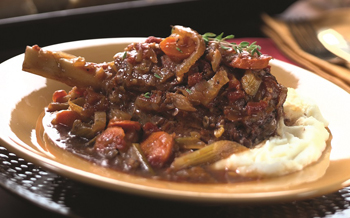Braising Away … with American Lamb
04 October 2013
 Braised lamb is economical and efficient. A successful lamb braise intermingles the flavors of foods being cooked, the aromatics employed and the cooking liquid—performing a magical transformation of lamb while adding body to the braising-liquid-turned-sexy-sauce.
Braised lamb is economical and efficient. A successful lamb braise intermingles the flavors of foods being cooked, the aromatics employed and the cooking liquid—performing a magical transformation of lamb while adding body to the braising-liquid-turned-sexy-sauce.
By Robert N. Corey, BA, AOS, CEC, EWS
Braising is for meat lovers. I have a passion for braised lamb shanks, an infatuation for sous-vide lamb necks, a serious affair going on with braised stuffed lamb breast and, from my very first taste of lamb, I have leg-of-lamb ecstasy.
While lamb is often considered an expensive meat for classroom use, braising allows me to focus on economical cuts of lamb. Thanks to the braise, I can find plenty of economical cuts for the long-simmered, wait-until-you-taste-this, top-of-a-heap goodness. My students will learn that dinner can be less expensive, and in all cases much more flavorful, when American Lamb meets a cook who can braise. This article will discuss the critical points of braising as related to utilizing, and enjoying economical cuts of American Lamb.
Braising evokes ancient magic that cooks around the world have performed for centuries. The method might necessitate a heavy cooking container with a French name, a modern steam-controlled oven or perhaps a place to just bury the container under coals or burning embers. Whatever the set-up, braising is the perfect technique for preparing tough locomotive muscles of beef, lamb, pork and other domestic or game animals. Cooking tough meats over time in the presence of a flavorful liquid, braising follows a few simple, set processes. Now a refined classic method, braising results in an unctuous, texturally exquisite and satisfying food that restaurants from diners to haute cuisine embrace with vigor.
By definition, “to braise” is to cook meat (and/or vegetables) by lovingly browning in fat and then cooking slowly in a closed pan with a small amount of liquid. Easy to make, but not simple. The process and the verb come from the French braiser, especially from Old French brese for“live coals” and probably of old Germanic origin. It can be compared to Old English brædan and Old High German brātan, both meaning “to roast.”
The braising times will fluctuate depending upon the size of the cut and the temperature at which the braise is maintained.
The classic French technique of braising relies upon three aspects that a cook, having a bit of experience in the method, may effectively maneuver to produce desired results. The three aspects are heat, time and moisture, all which serve to break down connective tissues and collagenin meat(e.g., the lamb shoulder, shank or neck), making it an ideal way to cook tougher cuts of lamb.
All cooking is about controlling heat and moisture, without exceptions. Everything is at the beck and call of that precept. If you can control heat during the wet braising you will be able to control the moisture of the protein. Pressure cooking, slow-cookingcrockpots and sous-vide methods of cooking in pressure-packed, sealed plastic bags utilizing temperature-precise water baths are considered forms of braising.
As a chef and educator I like to teach the science behind cooking methods. Braising is taught as a combination cooking method using both moist and dry heats. What we are looking for, nay, demanding, is an unctuous, collagen-rich, viscous, moist and tasty morsel of braised lamb. Typically, the food (shank, shoulder, neck, stew meat) is first de-fatted, then searedat a relatively high temperature in neutral oil and finished in a covered pot with a bit of liquid. The resulting flavor is particular to the browning of the meat and the variable wine, stock or other liquid used. Whole-muscle braising differs from its cousin, stewing, in that stew meatis cut into smaller pieces and is totally immersed in liquid, and from covered roasting, in which no liquid is added. Braising is, thus, a combination of covered roasting and steaming.Regardless of the definition, the resulting sauce (see my recipe for Chile-Braised American Lamb Shoulder) is absolutely essential to be served with the cooked lamb, for therein lies the flavor. The definitive tactile chew and texture of what we expect from braising lamb, however, is in the meat.
Most cooks follow the same basic steps for braising. The piece of lamb to be braised is first dried completely, seasoned vigorously and seared to brown its surface and enhance its flavor. This process is known to cooks as the Maillard reaction. Hugely important in the braising process, the Maillard reaction is often referred to as the “browning” of food, and is the most important reaction in hot-food cooking. The browning reaction description is incomplete at best. The important thing about the Maillard reaction isn’t the color—it’s the flavors and aromas. Indeed, it should be called the Flavor reaction, not the browning reaction! What begins as a simple reaction between amino acids and sugars in the lamb protein quickly becomes very complicated. The molecules produced keep reacting in ever-more-complex ways that generate literally hundreds of various molecules.
 The Maillard reaction occurs in cooking of almost all kinds of foods, although the simple sugars and amino acids present produce distinctly different aromas. This is why baking bread doesn’t smell like roasting lamb or frying fish, even though all these foods depend on the same reactions for flavor. The absence of the Maillard reaction distinguishes the flavors of boiled, poached or steamed foods from the flavors of the same foods that have been grilled, roasted or otherwise cooked at temperatures high enough to dehydrate the surface rapidly at temperatures above the boiling point of water. These two factors, dryness and temperature, are the key controls for the rate of the Maillard reaction. Again, controlling heat and moisture is crucial in all cooking and ultimately in perfecting the braising of our American Lamb, as well.
The Maillard reaction occurs in cooking of almost all kinds of foods, although the simple sugars and amino acids present produce distinctly different aromas. This is why baking bread doesn’t smell like roasting lamb or frying fish, even though all these foods depend on the same reactions for flavor. The absence of the Maillard reaction distinguishes the flavors of boiled, poached or steamed foods from the flavors of the same foods that have been grilled, roasted or otherwise cooked at temperatures high enough to dehydrate the surface rapidly at temperatures above the boiling point of water. These two factors, dryness and temperature, are the key controls for the rate of the Maillard reaction. Again, controlling heat and moisture is crucial in all cooking and ultimately in perfecting the braising of our American Lamb, as well.
Once we understand that the browning of the lamb protein (which helps to create the finished color of the sauce) most importantly produces flavor, we are well on the way to understanding the braising process itself. A small amount of cooking liquid that often includes an acidicelement (such as tomatoes, beeror wine)is added to the pot, often with stock. A classically braised dish is typically done with a relatively whole cut of meat (such as a lamb shank) and then the braising liquid is added to cover approximately two-thirds of the meat. The dish is brought up to temperature (a near boil) on the stovetop and then cooked, covered, at a very low simmer(usually in an oven) until the shanks are fork tender (approximately one to two hours at 350°F). Knowing that much of the flavor of a braised lamb dish is transferred into the cooking liquid, that liquid is required to be degreased, reduced and finished to create a saucethat accompanies the lamb that has been braised, usually coating the meat in a lacquer-like, glossy coat, emulating the paint job on a 1955 Chevy Corvette rolling off the assembly line.
A successful lamb braise intermingles the flavors of the foods being cooked, the aromatics employed (especially leeks, onions, carrots, rosemary, parsley, garlic, sage and thyme for American Lamb) and the cooking liquid (pure water, red wine, veal or lamb stock, etc.) being utilized. Braising performs the aforementioned magical transformation of lamb as the long, low-temperature slow cooking dissolves collagen into gelatin, enriching and adding body to the braising-liquid-turned-sexy-sauce. Braised lamb is economical, as it allows the use of tough and inexpensive cuts, and also efficient, as it often employs a single pot to cook an entire meal.
Familiar braised-lamb dishes might include Greek lamb with olives and feta, French-style navarin of lamb and Moroccan tagines, among others. These examples utilize a variety of liquids in the braised dish. A braise may incorporate water, tomato sauce, soy sauce, fish sauce, beef or chicken stocks and red or white wine for manipulating flavors.
Braises are found in all cultures. From Brazilian feijoada to Oaxacan mole to Louisiana Gumbo, all braises are required to have a particular thickening of the sauce, either flour-based or by reduction—it only matters to the artist. Whether the velvety shine of flour-thickened sauces or the lacquer-like shine of purely reduced sauce, the lamb braise satisfies our need for food from the hearth and comfort of home.
A good braised lamb dish, while seemingly simple, has many particular issues to pay attention to: removing the interior fat, the browning of the lamb, controlling time and temperature, degreasing to once again refine the flavors, reducing the flavorful braising liquid to the correct and desired viscosity, and the final seasoning. The recipes mentioned below rely on good instruction and a cook’s innate ability to manipulate time and temperature. Braising can take three hours, eight hours, 15 hours or even 72 hours. It will depend on the type of braising used, the particular cut of lamb and how the temperature is regulated—all subjective to the cook’s whim.
And finally the lamb braise is done. The aromas, textures and flavors are all so intoxicating. Dinner is served.
Chile-Braised American Lamb Shoulder and Greek Wine-Braised Lamb Shank “Cannelloni” are two of my favorite braising recipes for the culinary classroom utilizing American Lamb. See the downloads at the end of this article.
The following are additional favorite braising recipes from the American Lamb Board:
http://www.americanlamb.com/food-service/lemon-braised-lamb-shanks/
http://www.americanlamb.com/food-service/braised-curried-american-lamb-shank-with-yucca/
http://www.americanlamb.com/food-service/american-lamb-neck-croquettes/
http://www.americanlamb.com/food-service/tender-lamb-and-heart-of-palm/
http://www.americanlamb.com/food-service/braised-denver-ribs/
http://www.americanlamb.com/food-service/cabernet-braised-american-lamb-shoulder-with-rosemary-and-bay-leaves/
Robert N. Corey, BA, AOS, CEC, EWS, is a chef/instructor at Johnson & Wales University in Denver.
